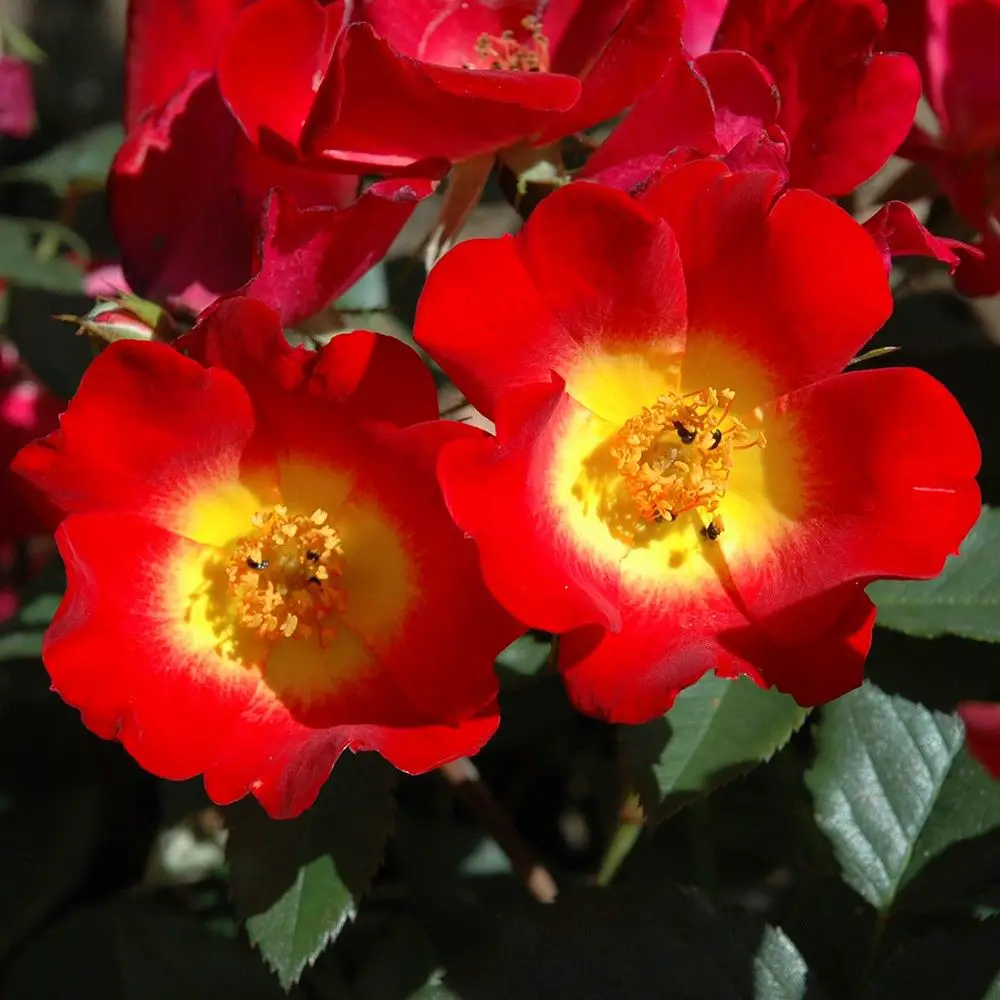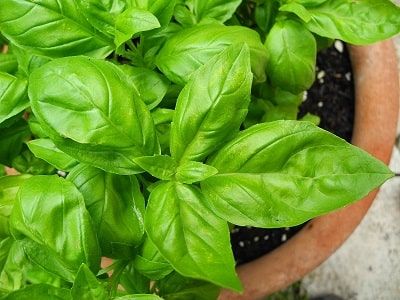Translated by Nick R
I’m sure you’ve heard about this kind of plant. And how could you not when climbing plants are one of the best options for decorating thanks to their wide variety of colors and scents.
Your house facade, garden, home walls, or even establishments like restaurants will look spectacular with these stunning plants. Would you like to know more about climbing plants? Well, this blog is for you.
I’ll talk about their meaning, the types that exist, the supports that work for climbers, the conditions they need, and how you can plant and care for them. Finally, I’ll give you a top 5 climbing plants for you to know their main features.
Table of Contents
What are climbing plants?
In general terms, climbing plants are distinguished by using some living or dead structure to parasitize mechanically. They host on this element but without consuming any substance to feed on.
However, climbers are a group of plants divided into several types, which we’re going to discuss below to better understand their meaning.
Climbers
These are lively plants that have the ability to produce long stems in a short time. These stems are more or less lignified, i.e. woody, which allows them to cling to various elements or supports.
In fickle plant species, that twine around some support such as Phaseolus coccineus (also known as runner beans) and Phaseolus vulgaris (or common beans), the stem looks for something to twine around after reaching a significant height.
This process can occur in one or the other direction and varies according to the contact, light, or heat stimulus to which the plant is exposed. As it grows, it narrows around the support using considerable twisting force.
You can also find other species, especially tropical ones, that make use of tendrils in order to twine around the supports. These tendrils are long, slender, and voluble organs found on stems or leaves.
Other species, such as Lathyrus odoratus or sweet pea, have tendrils as leaf extensions. And in species such as Gloriosa superba or also known as Flame lily, the tendril is at the tip of the leaves as a hook.
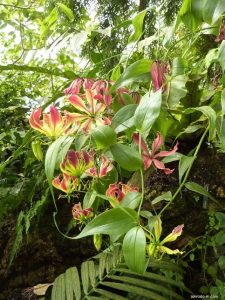
Sarmentose
These plants have long, flexible stems with the ability to grow towards the ground or upwards but have no specific support to attach to, although you can adapt them to one. Sarmentose can be lignified or semi-lignified and are characterized by their vigorous growth.
The stems of some varieties of these plants develop thorns or barbs that help them cling to support and also use them as a defense. Roses are one example of these species.
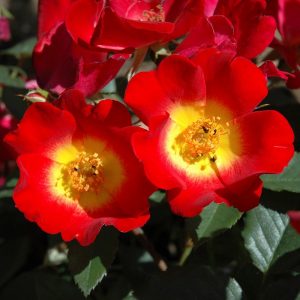
Semisarmentose
In this group, we can find shrubby plants that are not climbers, but that can adjust to growing against a wall, such as Pyracantha or also known as Firethorn.
The semisarmentoses are well suited to cover fairly large portions of walls. Something that climbing plants cannot achieve as effectively.
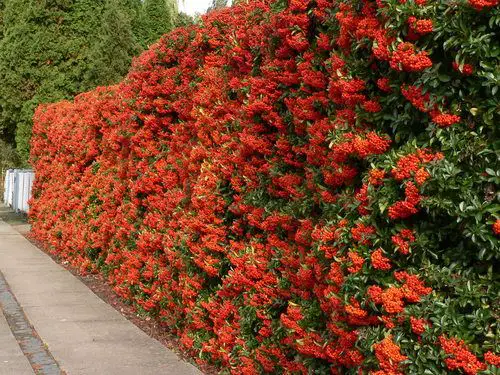
Supports for climbing plants
As I mentioned before, these plants stick around certain supports in order to climb on them. There are 2 types, the natural ones and the artificial ones. Next, I’ll explain what each one of them consists of.
Natural supports
It refers to vegetal supports, especially trees and shrubs in the garden. Preferably those that are mature and have open crowns, i.e. the upper part of the tree.
I would suggest using varieties of climbers that create a contrast with the tree leaves. This way, your garden will look much more beautiful and natural. Also, you don’t need to worry about the tree because climbers, despite growing on top of the tree, won’t take nutrients from it.
The substrate will be what contains what they need to grow and develop with no problems; it depends on the species of climber you plant. We’ll go into more detail on this subject later.
Artificial supports
These supports can be located inside or outside your home or anywhere else. What is important is that they should be in harmony within a space in terms of size, color, texture, and shape, among others. That’s up to your liking.
You can also create a different look to walls, angles or other structures that seem empty. A great advantage of these plants is that they work to divert attention from whatever you want to go unnoticed, such as garbage cans or warehouses for your tools.
These are some of the structures that will help you position
your climbing plants and give them the support they need.
Pergolas
This group also includes structures such as kiosks, arbors, pavilions and gazebos, which work well to support these wonderful climbing plants. Now, in broad terms, you can use pergolas with these minimum dimensions: 2 m (6 ft.) high and 1.5 m (4 ft.) wide.
In this way, the plants will look much more even since they could lose their appeal by being so far apart. You can choose to have a vine arbor that will make your garden look beautiful.
The vine arbor is a sort of path composed of pergolas at the top, and columns to support the pergolas. It offers a gentle shade and you can use it to connect the interior of the house with the exterior or to set up a dining area in it.
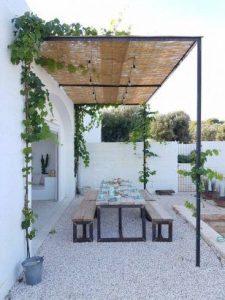
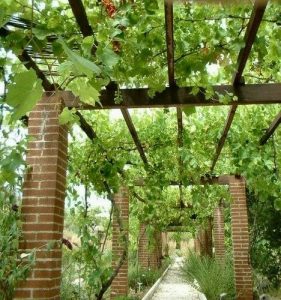
Archways
Such structures can be made of wood or metal. They work to delimit certain areas in the garden or grow different plants at regular intervals.

Trellises
These are interlocking structures that will make the garden look taller and more stylish. They make the walls thicker and deeper, which draws attention to them.
They can have a great variety of styles and sizes and be made of different materials, the most used is wood. However, the wood must resist the exterior, such as cedar, or be covered with a special varnish or lacquer to protect it.
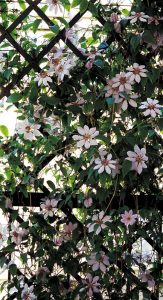
Columns and pillars
Climbing plants work very well for covering vertical structures such as columns, lantern posts and statues. There the plants can grow and, as they take the shape of these structures, give them a fantastic look.
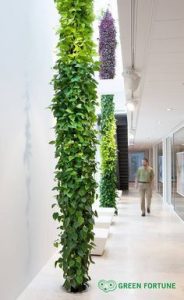
Cultivation and care of climbing plants
Now that we’re familiar with the meaning of climbing plants, the types that exist, and where we can place them, let’s talk about how to grow them and how we can take care of them.
Cultivation of climbing plants
Reproduction
This species of plants can be reproduced by seeds, plant division, or cuttings. Regarding seeds, species such as Tropaeolum (Nasturtium) or Ipomoea (morning glory) have seeds that can be sown outdoors in spring.
However, if you want to achieve good results, you can sow the seeds on a substrate suitable for them in winter or early spring.
You place them in a warm and shady place. When they have germinated, it’s necessary to help them acclimatize to the outside little by little, as long as there is no risk of heavy frosts.
You should know that you won’t always obtain results by sowing seeds because it is more difficult for the plant to germinate. Therefore, there are other methods, such as plant division or cuttings.
Plant division consists of separating the scions or shoots from the mother plants in autumn. This process is used for species such as Campsis (Trumpet Vine), Celastrus (Staff Vine), and Wisteria (Chinese Wisteria or Glycine).
If the scions belong to a very delicate species, you can store them during the winter in a cold-proof container with sand. In March you can plant them in a pot until they stick well to the substrate and are in good conditions to be outdoors.
If you want to reproduce your climbing plants by cuttings, you need to take woody cuttings at least 15 cm (6 in.) long in autumn. It applies to species such as Wisteria or Parthenocissus.
During the winter, at a temperature of 3°C, you can keep the cuttings in a mixture of sand and peat. In early spring you can transplant them so that they develop a bit more and in autumn or next spring you transplant them to their definitive place.
If you take semi-woody cuttings you’ll need to do it in summer and take them from the side shoots of the mother plant. They should be firm at the bottom and soft and green at the top. You can shelter them in a home greenhouse so that they don’t dry out or get affected by other factors.
For this type of cuttings, you may use hormones to help them develop the roots they need.
Cultivation needs of climbing plants
Like all plant species, climbers have some cultivation needs for proper development and growth. Regarding climatic conditions, it’s essential to know the climate conditions of the area in which you live.
I recommend being aware of the needs of the climbing plant you want; some like to be placed towards the south or west, and others like a northern or eastern exposure. The appropriate temperature and light for each plant depend on this.
Species such as Campsis or Rose require direct sunlight but are able to survive in semi-shaded environments, though they’ll produce fewer flowers and fruits.
The terrain is also a fundamental aspect to consider for the cultivation of your climbing plants. The optimal substrate for this species of plants should be rich in organic matter and should guarantee adequate drainage.
Annual species will adjust to small amounts of substrate, as long as it is fertile. Most climbing species adapt without problems to acid or alkaline soils, so you can maintain a neutral pH level.
You must be aware of the dimensions, in terms of height and width, of the climber species you’re going to plant. If, for example, you want them inside your house and the space is small, you will have to go for species no taller than 3 m. When they grow too tall, they might cover the windows, as well as darken the garden views or clog the roof drains.
Also, if the climbers you choose are very robust, a fragile support won’t be able to support them, so you must find a balance between the plant and the supports or structures on which it will be located.
Crop preparation
If you’re planting directly into the garden soil, you need to prepare the area in advance. After choosing the location to sow the plant, you’ll dig a hole 40 to 50 cm (16 to 20 in.) deep. I suggest doing this in autumn.
If the soil is too clayey you can break it up a little with a proper tool such as a hoe, and add gravel so it won’t be packed and will have good drainage. On the other hand, if the soil is clayey and wet, it’ll be necessary to make a drainage channel at least 50 or 60 cm (20 in.) deep.
Another tip is to add decomposed manure and other organic materials to improve the quality of the soil. Once it’s ready, you should level it, compact it and let it rest for it to acquire an adequate structure and become fertile.
To plant your climbers in pots, wait from October to early spring, always ensuring adequate drainage in the container. In addition, pots are suitable for species that grow no more than 2 m (6 ft); with the help of pruning, you’ll be able to keep the plants at a proper size.
You can use universal substrate, available in nurseries or specialized stores, rich in nutrients, with perlite and that guarantees good drainage.
Watering should be done when the substrate begins to dry out, which you can check with your finger. You only have to dig it at least 2 cm into the soil and if it comes out clean then you’ll have to water, otherwise, it won’t be necessary. In very hot seasons, you will probably have to water twice a day, without waterlogging the substrate.
Do not forget that, when the plants are in pots, it’s necessary to fertilize them, or else they won’t have the necessary nutrients to develop properly; you can use a liquid fertilizer.
Climbing plants in pots need to be repotted every 3 or 4 years. I advise you to use heavy pots such as terracotta pots, thus neither the plant nor the support will destabilize the container.
Care of climbing plants
Watering
As you may have figured out, this plant species doesn’t like overly moistened substrates; however, that doesn’t mean that you should let them dry out completely.
In the summer season, they’ll need more regular watering as this is the growing season, but remember not to overdo it or flood the plant. Watering should be done just to keep the substrate sufficiently moist.
If your climbers are close to a brick or concrete wall, they’ll need abundant watering as these structures can absorb moisture from the soil and affect the plants.
Mulching and protection
For those species of climbers that are somewhat fragile, it’ll be necessary to keep the roots in the shade and protected from high or low temperatures. To achieve this, you can use a mulch with a layer of 4 or 5 cm (2 or 3 in.) of compost, bark, straw or other organic material that will help retain moisture.
You may also use a mulch made of polyethylene or hemp to protect the plant’s canopy in the event of extreme cold winds. If you live in very hot areas, you can offer your plants some shade in the afternoons.
Fertilizer
Plants that are grown directly in the soil and have soil rich in organic matter and are mulched once or twice a year don’t require fertilizers.
But if, on the contrary, your plants are in pots, as I have already mentioned, it’ll be necessary to use compost or fertilizer. You can do this when the plants are about 30 cm (12 in.) high.
The compost or fertilizer you use should be balanced in terms of NPK (nitrogen, phosphorus and potassium). Avoid higher levels of nitrogen compared to the other elements, because although nitrogen helps with vegetative growth, it affects the development of the flowers.
Tying
Once you finish planting, you need to tie the plants to the supports, this way they’ll start to grow into their shape. You don’t need to tie them too tightly to allow the stems to grow.
You can use a piece of cloth, rubber or plastic to tie the stems to the supports. Don’t forget to check the ties periodically and replace them every year.
Pruning
Pruning helps to give your climbing plants the shape, structure, and size you want. This way, the plant will be encouraged to form lateral branches, and flowers and stay healthy.
Pruning can be done when planting, so the plant will devote its energies to root development. For annual plants, you can prune a portion of the older stems. For this, you can count 45 cm from the base of the plant upwards and prune above this point.
Rejuvenating pruning can be done in spring when the new vegetation begins to develop. Of course, this process may vary a little depending on the species. For this reason, you must get informed about the care needed for these species.
Pests
Climbing plants can be affected by parasites, fungal, bacterial and viral diseases. If your plants are being attacked by any pest, you should treat them with appropriate insecticides or pesticides, but not excessively.
You should remove the affected shoots so that they don’t infect the other plants as well as encourage the appearance of beneficial animals such as ladybugs or insectivorous birds. Always use clean tools to handle the plants and avoid the transmission of diseases.
Top 5 climbing plants
Since you know a little more about these wonderful plants, I want to introduce you to 5 of the most common that you can have in your garden or inside the home. You’ll love them!
| Creeper species | Characteristics |
| Clematis – Clemátide | Origin: Europe, Asia and America Light exposure: they require direct sunlight, but should be protected during the hottest hours. Flowering: April to October Height: it grows up to 10m (33 ft.)Pests: it can be affected by aphids and snails. Description: it’s a genus with a great variety of species whose flowering can be in spring, autumn and summer. The flowers consist of 4 or 5 oval petals in the shape of a cup, bell, or urn. Cultivation: they can adapt to alkaline soils. It’s a genus that has rustic and semi-rustic species. The latter require protection as they are very delicate. Clematis reproduces by cuttings, and pruning varies according to the flowering season of each species. The ones that flower in spring should be pruned after this process, while the ones that flower in summer and autumn should be pruned at the end of winter. |
| Creeper species | Characteristics |
| Ficus pumila | Origin: China and Malaysia (F. diversifolia) Light exposure: it tolerates direct sunlight, semi-shade and shade. Height: it grows up to 2 metersPests: it’s affected by mealybugs Description: F. pumila is a perennial plant with small, dark green, oval, acute leaves. F. diversifolia is an indoor species that grows up to 30 to 60 cm (12 to 24 in.) tall. Cultivation: F. pumila can be planted outdoors, F. diversifolia is a delicate species that require protection. It can be reproduced by cuttings. |
| Creeper species | Characteristics |
| Wisteria – Glicina | Origin: China, Japan and South America Light exposure: it can tolerate direct sunlight and semi-shade.Flowering: spring flowering Height: over 15 m (50 ft.)Pests: it’s affected by aphids and red spider mites. Description: its flowers are gathered in clusters of inflorescences. They are fragrant and lilac, light blue, pink or white flowers. It has deciduous leaves, with a light green color and pinnate. Cultivation: they like deep well-drained soils, and that are not calcareous. They can withstand low winter temperatures. Young shoots require support and they should be pruned in July to shorten the branches and in winter so as to leave a couple of buds. They can be reproduced by cuttings. |
| Creeper species | Characteristics |
| Jasminum polyanthum – Jasmine | Origin: boreal or northern hemisphere Light exposure: it tolerates a great amount of light, but not direct exposure. Flowering: depending on the species it can occur in winter, spring and summer.Height: up to 15 meters depending on the species Pests: it can be affected by mealybugs and aphids. Description: Its flowers can be white, yellow or pink and are gathered in inflorescences. Its opposite leaves are pinnate and can have different features. Cultivation: Several species are semi-rustic and somewhat delicate, so they should be kept indoors, or outdoors in summer and protected in winter. They can adapt to various types of soil, as long as it has proper drainage. Pruning should be done after flowering to encourage the development of new shoots. |
| Creeper species | Characteristics |
| Rosa Wedding day – Rosal | Origin: boreal or northern hemisphere Light exposure: it tolerates direct sunlight and semi-shade. Flowering: spring or summer Height: it can vary according to the species Pests: it can be attacked by powdery mildew, rust, gray mold, peronospora, aphids, red spider mite, ketonia, among others. Description: climbing species of roses are vigorous, and have simple, small, clear, fragrant flowers that gather in inflorescences. These plants have hooked thorns for clinging to the supports. Cultivation: you can use a mulch of straw, peat, bark, or organic matter. They can adapt to any type of soil, but prefer well-drained, fertile, clayey soils with little lime. Pruning should be done to remove old or damaged shoots. It can be reproduced by seed or grafting. |
We’ve got to the end of this exciting blog about climbing plants. As you could notice, their cultivation is very easy, and their care is not too demanding. So you can safely grow your plants while learning about every species.
I assure you that you won’t regret this experience, this type of plant species will help you bring a new design to your garden or home. Just keep in mind the recommendations I gave you and get to work.
